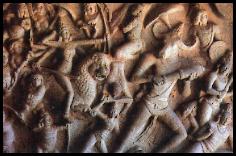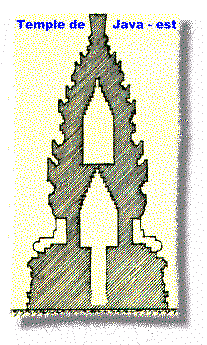

If you decide one day to visit Borobudur one Sunday, you will note, with your depend, that it is swarming with people.
If Javaneses like this monument so much, it is because it is the one which corresponds best to the idea they have about the world of the gods and ancestors. The mountain, terraces in steps, a pyramidal sanctuary. Let us note besides that such a sanctuary precisely existed where Borobudur was built.
This is perfectly clear when one follows the evolution of the javanese sanctuaries over 2000 years.
The firsts, probably dating from the beginning of our era, even before, were megalithic terraces built on the blanks of the mountains and even at the top. One still finds examples of them, but they are much more recent, in the Sunda country, also at the top of mount Yang, in east Java. Between 10 and 15 terraces are followed always higher. Not large monuments, but of the small altars, menhirs representing the spirit of the ancestors, and the small anthropomorphic statues of stone. One finds exactly the same thing in Toraja land Sulawesi with their famous Tau Tau on the balconies.
When the great Indian religions will unload, it is they which will make the fashion: new gods, new temples, new rituals. These new temples will be initially built on the mountains, like the old ones - not of too abrupt changes ! - it is the case of the Dieng temples or Gedong Songo temples, then more and more low, and finally in the plain around the royal capital. It will be the case for the kingdoms of central Java then of Java east until the 14th century. At this time there, change of the scenery because the fresh breath of the new hindouists concepts of the divine does not arrive any more to Java: India keep silent itself under the arm armed of Islam. The natural base of the Javanese beliefs returns in great rush. The new temples are built with terraces which are superimposed either in height but in the direction depth as with Candi Panataran. 100 years later, massive Islamization of the plains helping, one re-hoists the temples on the blanks of the mountains, like Candi Sukuh; the terraces in steps are unrolled, then as time will pass, the structure of the temple will decrease in dimension until being any more but an altar, of pyramidal form of course. Good-bye Trimurti ! good-bye Buddha! Hourrah for the sky, the thunder, and the regenerating lightning !
Why temples of Java are called CANDI (to pronounce TCHANDI) ?
Indeed, the word Candi is not of Javanese origin , but a word Sanskrit, therefore coming from India. However, in India, the temples are not called Candi; they are indicated by words such as DEVALAYA (remains gods), PRASADA (palace) or VIMANA (construction on floors, used for the large sanctuaries of South India ). And in Bali, the island close to Java and still hindu, they are called PURA (word Sanskrit meaning like PURI, city or capital).
Force is to note that the specialists writers are not prolix on the subject. In fact they do not answer the question or in a word, with the choice: Candi means old throne , or Candi is another name to indicate Durga. And it is all...
Here is my explanation:
Candi is the name of the Mother Goddess (V. Célébration de la Grande Déesse- Devi-Mahatmya or Chandi, trad. of J. Varenne), that who is born from the cosmic energy of the gods to save the world threatened of destruction by the demons after the latter had overcome the gods.
Candi, armed with supreme weapon from each one of gods (the three-pronged fork of Shiva, the disc of Krishna etc), and overlapping the lion of the god of the mountain Himavan (which will give the name Himalaya) , will fight the armies of the demons (they are innumerable), led by a buffalo (which does not have a name because only the men have some). After having killed all the demons, in a last gigantic battle, she will kill the buffalo demon which she will transpierce with its three-pronged fork. It is the well-known image.
As in India nothing never finishes, the goddess will owe play again her role several times. She will change name, and will be called Chandika or Ambika or Durga.

This image was present on the majority of the hindu temples of central Java (those devoted to Shiva), and on many temples of east Java .
But let us return to the explanation:
One can thus think that the farming populations of Java venerated the Mother Goddess and goddess of the fertility (like all the farming populations of the world), because she is the only one at the same time able to make push the plants and to help and save the peasants faces with all the mortal dangers which watch for them. The text above say : "you are called Durga because you are a ship without fastener, with which one crosses the ocean of the difficulties".
In Java, 1000 years ago, this divinity was to be called Candi and not Durga like today. She was venerated by the peasants who brought offerings to her image on the temple, whereas the sovereign venerated the lingam locked up in the cella. She had her festival, and finally, with time, and whereas the sovereigns had changed and perhaps deserted the cella, the name of the goddess, Candi, ends up becoming the generic name to indicate the temple itself that the peasants continued to attend. Later and still now, Candi indicates all the old temples, even Buddhist.
There
is currently the well known example of the temple of Prambanan
which the population calls neither Candi
Prambanan, nor Candi Shiva, but Lara
Jonggrang. It is the name which they gave to the image of Durga,
represented by a superb statue, but which for them is a Javanese
princess statufied by a demon, which is now venerated. Thus, the
name of the princesse/goddess became the name of the temple.
The temple of central Java is a structure of a square or cruciform plan. It is a complex of which the principal structure is in the center of the enclosure. It is made of three parts: the base, the body of the sanctuary, and the superstructure formed of decreasing square stages. The access to the cella was closed by two wooden gates . On the top of the door of entry is represented a terrible head of Kala, with an opened large mouth, which one must enter to reach the cella. The head of kala personifies time; to enter the Holy of Holies, it is to change universe. The interior of the sanctuaries also arises in three parts. The base which include a pit in which was deposited a stone box containing some invaluable or sacred objects (pusakas), the body of the building which contains a small square cella intended to shelter the image of the divinity, and a small room which is hidden in the superstructure. The gargoyles are often appeared as a Makara, fantastic aquatic animal with a head of an hippopotamus , a trunk of the elephant, and an open mouth spitting of chains of flowers of lotus or pearls.
The
temple could be enclosed in a square collar with triple or
quadruple row of small temples or of chapells. The eight
directions, i.e. the four cardinal points and the four axes are
marked by small lingams.
 The temples of east
java :
The temples of east
java :They look like those of central Java with however some differences. The base is much higher constituting several terraces. The body of the sanctuary is notably narrowed in the median part. Lastly, the pinnacle is of cubic form , it finishes flat and not at a peak. Makara being used as gargoyle are replaced by Naga. From the 14th C., the principal sanctuary will be located at the bottom of the enclosure and one will reach it after having to cross several large terraces in steps
Representations:
The temples intended for the hindu worships can shelter images of hindu Trimurti or images related to Shiva, in particular Durga, Ganesha the god with head of elephant son of Parvati, and Agastya the wise one, which profits in Indonesia from an exceptional popularity, whereas in India even, its image is very rare. Who hides behind this image? I put forth an assumption: if Shiva or the lingam represents the divine power whose sovereign is the terrestrial incarnation, one can then suppose that Agastya represents the mythical ancestor of the Brahmans, the one who know the laws and who teach the rituals essential to the good harmony of the kingdom. According to the hindu myths , Agastya is born of the seed of Mitra and Varuna; he is the Master of grammar, and for this reason, it is him who teaches the védic rituals.
In the temples of East Java , the images of the hindut Pantheon are next to those of Buddhism, in particular through their tantric emanations and their Prajna (female aspect).
In the bouddhistic temples , one will find images of the Buddha, the five jina (in particular in Borobudur) and of Bodhisattva especially Avalokiteshvara the Buddha of compassion, and Vajrapani. One finds also images of Tara (that which helps), female emanation of the Bodhisattva Avalokiteshvara.
Panels of reliefs drawn from great hindo/bouddhistic épics, telling the religious canons or the adventures of the gods and the heroes cover the walls of certain temples. One will find also moral tales drawn from the stories of Tantri, and also, in east Java , stories purely Javaneses drawn from the wayang, the shadow theatre. Let us not forget finally, that at the time, all the monuments were painted with sharp colors .
One will not find in east Java the immense sanctuaries like Candi Borobudur, Prambanan or Sewu, of central Java. Indeed, as from the 10th century, the " international trade " will develop and, due to a greater economic prosperity with an over-production of rice, the aristocracy will succumb to the attraction of the luxurious products from abroad like the silk from China or the cotton from India, and this with depends on the construction of the temples.
It is at that time that will be introduced in Java the first Indians " batiks" , whose technique will become later a great Javanese speciality. Many temples nevertheless will be built, and their more modest dimension will be compensated by a sophistication of the ceremonies which will become imposing and solemn, such as those which are still applied currently in the kraton of Yogyakarta.
The
temple is initially the residence of the gods, it is a microcosm
of the celestial mountain. Later, they could be devoted to the
déified sovereign. Many steles carved with the effigy of the
kings, princes or princesses are visible inside sanctuaries of
East Java , for example at Candi
Singhosari. One did not find royal ashes under the javanese
temples .
![]()